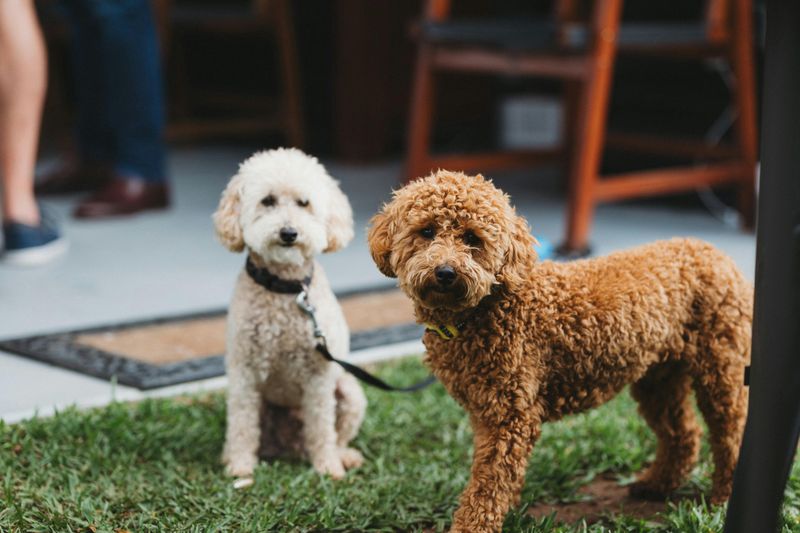Labradoodles and Goldendoodles may look like cousins at a family reunion, but don’t be fooled—they’re not the same dog in different coats.
One’s got a little more go-go-go in their step, the other leans into cuddles and charm. And when it comes to grooming, shedding, and how they act around kids or strangers? The differences might surprise you.
You don’t want to bring home a whirlwind when you were hoping for a lap dog—or expect a chill vibe from a pup who’s always chasing squirrels. That’s why knowing what truly separates these two fluffy favorites can save you a lot of stress (and vacuuming).
So before you pick the doodle that melts your heart, make sure it also fits your life. Because behind those teddy bear eyes? There’s a whole lot of personality waiting to meet its match.
Coat Type

The coat is often the first distinction noticed between these breeds. Labradoodles typically have a wavy to curly coat, resulting from their Labrador and Poodle heritage. This makes them a great choice for those looking for hypoallergenic pets. Meanwhile, Goldendoodles generally boast a looser, fluffier coat, influenced by the Golden Retriever genes. The difference in coat texture can influence grooming needs and shedding levels. Labradoodles might require more frequent grooming, while Goldendoodles may shed more seasonally. In both cases, regular maintenance is key to keeping their fur healthy and tangle-free.
Temperament

Both breeds are celebrated for their friendly and social nature. However, Labradoodles often exhibit a more energetic and spirited demeanor, reflecting their Labrador lineage. In contrast, Goldendoodles tend to inherit the calm and gentle disposition of the Golden Retriever. This makes them ideal companions for families seeking a laid-back pet. The difference in temperament means Labradoodles might require more active playtime, while Goldendoodles enjoy casual lounging. Understanding these nuances helps prospective owners choose the right fit for their home environment and lifestyle.
Training Ease

Training a doodle can be a delightful experience due to their intelligence. Labradoodles, with their Labrador genes, show a keen eagerness to please, making them quick learners. Goldendoodles also possess this trait, but their Golden Retriever background often gives them an extra dose of patience and attentiveness. This can make Goldendoodles slightly more adaptable to longer training sessions. Both breeds thrive on positive reinforcement methods and enjoy mental challenges. Owners should tailor training techniques to suit each breed’s unique learning style, ensuring a rewarding and fun process.
Exercise Needs

Exercise is vital for these active breeds, but their needs can vary. Labradoodles, thanks to their Labrador ancestry, may have a higher energy level and a love for water activities. They thrive in environments where they can run and swim freely. On the other hand, Goldendoodles, while still energetic, might be content with a brisk walk or a playful fetch session. Catering to these exercise demands is essential to keep them healthy and content. Prospective owners must assess their own activity levels to ensure they’re a good match for their pet’s lifestyle.
Size Variations

Size can vary significantly between the two breeds. Labradoodles come in three main size categories: standard, medium, and miniature, offering flexibility for different living spaces. Goldendoodles share similar size classifications but may lean slightly larger, influenced by the Golden Retriever’s size genes. This variance can affect space requirements and suitability for apartment living. Understanding these size differences helps potential owners choose the right companion for their home environment. Regardless of size, both breeds bring immense joy and companionship to their families.
Health Considerations

Health is a crucial factor in selecting a pet. Labradoodles are predisposed to hip dysplasia, a condition inherited from the Labrador side. Regular vet check-ups and maintaining a healthy weight can mitigate this risk. Goldendoodles, on the other hand, may face issues like hip dysplasia and heart conditions, owing to their Golden Retriever lineage. Routine health screenings and a balanced diet are essential for maintaining their well-being. Understanding these health considerations helps owners prepare for potential challenges and ensures their pet’s longevity and happiness.
Lifespan

When considering a pet, lifespan is a key element. Labradoodles typically enjoy a lifespan of 12 to 14 years, reflecting the longevity of both the Labrador and Poodle. In contrast, Goldendoodles may live slightly longer, averaging 12 to 15 years, influenced by the Golden Retriever’s genes. These numbers highlight the importance of providing a loving and healthy environment to maximize their years. Prospective owners should be prepared for this long-term commitment, ensuring both breeds receive the care and attention they deserve throughout their lives.
Popularity

Popularity often guides the decision to choose a pet. Labradoodles first gained attention as hypoallergenic guide dogs, quickly becoming family favorites. Their playful nature and adaptability make them highly sought after. Goldendoodles, with their friendly demeanor, are equally beloved, often featured in therapy work. This popularity can influence availability, with many breeders offering both. Understanding the demand for each breed can help prospective owners in their search. Both breeds offer unique qualities that have captured the hearts of dog lovers worldwide.
Grooming Requirements

Grooming is an essential aspect of caring for these breeds. Labradoodles, with their curly coats, require regular grooming to prevent matting and maintain a tidy appearance. This can involve brushing several times a week and professional grooming every few months. Goldendoodles, while also needing consistent care, might have less intensive grooming needs due to their looser coats. Understanding these requirements is crucial for maintaining healthy skin and fur. Prospective owners should consider the time and resources needed to keep their doodle looking and feeling their best.
Social Behavior

Social behavior plays a significant role in a dog’s compatibility with families. Labradoodles are known for their sociable and outgoing nature, making them excellent companions in active households. Goldendoodles, with their gentle and affectionate demeanor, are equally well-suited for family life. Both breeds enjoy the company of humans and other pets, thriving in environments where they receive ample attention. Understanding these social tendencies ensures a harmonious integration into family life, providing joy and companionship to all involved.
History and Origin

The history of these breeds adds to their allure. Labradoodles were first bred in the 1980s as guide dogs, combining the intelligence of Poodles with the temperament of Labradors. This heritage made them an instant hit. Goldendoodles followed in the 1990s, blending the Golden Retriever’s gentleness with the Poodle’s smarts. Their origin reflects a desire for hypoallergenic, family-friendly pets. This history highlights the innovative breeding practices that led to the creation of these beloved dogs, appealing to those seeking a pet with a rich and purposeful background.

